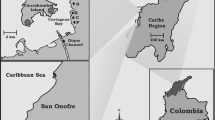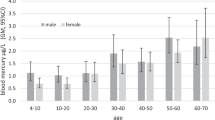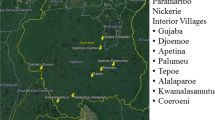Abstract
Selenium (Se) is an essential element and deficit or excess of dietary Se is associated with health disorders. Relatively elevated Se levels have been reported in the Brazilian Amazon, where there are also important annual variations in the availability of different foods. The present study was conducted among six riparian communities of the Tapajós River to evaluate seasonal variations in blood and sequential hair cm Se concentrations, and to examine the relationships between Se in blood and hair, and blood and urine. Two cross-sectional studies were conducted, at the descending water (DWS, n=259) and the rising water (RWS, n=137) seasons, with repeated measures for a subgroup (n=112). Blood Se (B-Se), hair Se (H-Se) and urine Se (U-Se) were determined. Match-paired analyses were used for seasonal comparisons and the method of best fit was used to describe the relationships between biomarkers. B-Se levels presented a very large range (142–2447 μg/l) with no overall seasonal variation (median 284 and 292 μg/l, respectively). Sequential analysis of 13 cm hair strands showed significant variations over time: Se concentrations at the DWS were significantly lower compared with the rising water season (medians: 0.7 and 0.9 μg/g; ranges: 0.2–4.3 μg/g and 0.2–5.4 μg/g, respectively). At both seasons, the relationships between B-Se and H-Se were linear and highly significant (r2=67.9 and 63.6, respectively), while the relationship between B-Se and U-Se was best described by a sigmoid curve. Gender, age, education and smoking did not influence Se status or biomarker relationships. Variations in H-Se suggest that there may be seasonal availability of Se sources in local food. For populations presenting a large range and/or elevated Se exposure, sequential analyses of H-Se may provide a good reflection of variations in Se status.
This is a preview of subscription content, access via your institution
Access options
Subscribe to this journal
Receive 6 print issues and online access
$259.00 per year
only $43.17 per issue
Buy this article
- Purchase on Springer Link
- Instant access to full article PDF
Prices may be subject to local taxes which are calculated during checkout





Similar content being viewed by others
References
Alaejos M.S., and Romero C.D. Urinary selenium concentrations. Clin Chem 1993: 39 (10): 2040–2052.
Baskett C.K., Spate V.L., Manson M.M., Reams C.L., and Morris J.S. The determination of selenium in urine. J Radional Nucl Ch 1994: 179 (2): 323–329.
Bratter P., Negretti de Bratter V.E., Jaffé W.G., and Castellano H.M. Selenium status of children living in seleniferous area of Venezuela. J Trace Elem Electrolytes Health Dis 1991: 5: 269–270.
Campagna D., Gobba F., Mergler D., Moreau T., Galassi C., Cavalleri A., and Huel G. Color vision loss among styrene-exposed workers neurotoxicological threshold assessment. Neurotoxicology 1996: 17: 367–373.
Campos M.S., Sarkis J.E.S., Müller R.C.S., Brabo E.S., and Santos E.O. Correlation between mercury and selenium concentrations in Indian hair from Rondônia State, Amazon region, Brazil. Sci Tot Environ 2002: 287: 155–161.
CARUSO. Mercury exposure and ecosystem health in the Amazon 2007: http://www.unites.uqam.ca/gmf/caruso/caruso.htm.
Cernichiari E., Toribara T.Y., Liang L., Marsh D.O., Berlin M.W., and Myers G.J., et al. The biological monitoring of mercury in the Seychelles study. Neurotoxicology 1995: 16 (4): 613–628.
Chang J.C., Gutenmann W.H., Reid C.M., and Lisk D.J. Selenium content of Brazil nuts from two geographic locations in Brazil. Chemosphere 1995: 30: 801–802.
Chunhieng T., Pétritis K., Elfakir C., Brochier J., Golu T., and Montet D. Study of selenium distribution in the protein fractions of the Brazil nut, Bertholletia excelsa. J Agric Food Chem 2004: 52: 4318–4322.
Combs Jr G.F. Selenium in global food systems. Br J Nutr 2001: 85: 517–547.
Dolbec J., Mergler D., Larribe F., Roulet M., Lebel J., and Lucotte M. Sequential analysis of hair mercury levels in relation to fish diet of an Amazonian population, Brazil. Sci Tot Environ 2001: 271: 87–97.
Dorea J.G., Moreira M.B., East G., and Barbosa A.C. Selenium and mercury: concentrations in some fish species of the Madeira River, Amazon Basin, Brazil. Biol Trace Elem Res 1998: 65: 1–10.
Dumont E., Vanhaecke F., and Cornelis R. Selenium speciation from food sources to metabolites: a critical review. Anal Bioanal Chem 2006: 385: 1304–1323.
Fordyce F.M., Guangdi Z., Green K., and Xinping L. Soil, grain and water chemistry in relation to human selenium-responsive diseases in Enshi District, China. Appl Geochem 2000: 15: 117–132.
Hansen J.C., Deutch B., and Pedersen H.S. Selenium status in Greenland Inuit. Sci Tot Environ 2004: 331: 207–214.
Harkins D.K., and Susten A.S. Hair analysis: exploring the state of the science. Environ Health Persp 2003: 111 (4): 576–578.
Hira C.K., Partal K., and Dhillon K.S. Dietary selenium intake by men and women in high and low selenium areas of Punjab. Public Health Nutr 2004: 7 (1): 39–43.
Institute of Medicine National Academy of Science, Food and Nutrition Board, Panel on Dietary Antioxidants and related compounds. Dietary Reference Intakes for Vitamin C, Vitamin E, Selenium and Carotenoids. Washington, D.C: National Academy Press eds, 2000.
Labat L., Dehon B., and Lhermitte M. Rapid and simple determination of selenium in blood serum by inductively coupled plasma-mass spectrometry (ICP-MS). Anal Bioanal Chem 2003: 376: 270–273.
Lebel J., Roulet M., Mergler D., Lucotte M., and Larribe F. Fish diet and mercury exposure in a riparian Amazonian population. Water Air Soil Poll 1997: 97: 31–44.
Leblanc A., Dumas P., and Lefebvre L. Trace element content of commercial shampoos: impact on trace element levels in hair. Sci Tot Environ 1999: 229: 121–124.
Lemire M., Mergler D., Fillion M., Passos C.J.S., Guimarães J.R.D., and Davidson R. . et al. Elevated selenium levels in the Brazilian Amazon. Sci Total Environ 2006: 366: 101–111.
Lima A.P.S., Sarkis J.E.S., Shihotomatsu M.H., and Müller R.C.S. Mercury and selenium concentrations in fish samples from Cachoeira do PiriáMunicipality, ParáState, Brazil. Environ Res 2005: 97: 236–244.
Longnecker M.P., Stram D.O., Taylor P.R., Levander O.A., Howe M., and Veillon C., et al. Use of selenium concentration in whole blood, serum, toenails, or urine as a surrogate measure of selenium intake. Epidemiology 1996: 7: 384–390.
Longnecker M.P., Taylor P.R., Levander O.A., Howe S.M., Veillon C., and Mc Adam P.A. Selenium in diet, blood, and toenails in relation to human health in a seleniferous area. Am J Clin Nutr 1991: 52: 1288–1294.
Mayne S.T. Antioxidant nutrients and chronic diseases: use of biomarkers of exposure and oxidative stress status in epidemiologic research. J Nutr 2003: 133 (Suppl 3): 933S–940S.
Miller R.C., Brindle E., Holman J.D., Shofer J., Klein N., and Soules M.R., et al. Comparison of specific gravity and creatinine for normalizing urinary reproductive hormone concentrations. Clin Chem 2004: 55: 924–932.
Morton J., Carolan V.A., and Gardiner P.H.E. Removal of exogenously bound elements from human hair by various washing procedures and determination by inductively coupled plasma mass spectrometry. Anal Chim Acta 2002: 455: 23–34.
Muckle G., Ayotte P., Dewailly E., Jacobson S.W., and Jacobson J.L. Prenatal exposure of the Northern Québec Inuits infants to environmental contaminants. Environ Health Persp 2001: 109: 1291–1299.
Passos C.J.S., Mergler D., Gaspar E., Morais S., Lucotte M., and Larribe F., et al. Caracterização do consumo alimentar de uma população ribeirinha na Amazônia Brasileira. Revista Saúde e Ambiente 2001: 4: 72–84.
Passos C.J.S., Mergler D., Lemire M., Fillion M., and Guimaraes J.R.D. Fish consumption and bioindicators of inorganic mercury exposure. Sci Total Environ 2007: 373 (1): 68–76.
Perreira R., Ribeiro R., and Gonçalves F. Scalp hair analysis as a tool in assessing human exposure to heavy metals (S. Domingos mine, Portugal). Sci Tot Environ 2004: 327: 81–92.
Pinheiro M.C.N., Müller R.C.S., Sarkis J.E., Vieira J.L.F., Oikawa T., and Gomes M.S.V., et al. Mercury and selenium concentrations in hair samples of women in fertile age from Amazon riverside communities. Sci Tot Environ 2005: 349 (1-3): 284–288.
Rayman M.P. The importance of selenium to human health. Lancet 2000: 356: 233–241.
Robberecht H.J., and Deelsta H.A.P. Selenium in human urine: concentration levels and medical implications. Clin Chim Acta 1984: 136: 107–120.
Robbins C.R. Chemical and Physical Behaviour of Human Hair, 4th edn. New York: Springer-Verlag, 2002, pp. 3 8–9.
Senofonte O., Violante N., and Caroli S. Assessment of reference values for elements in human hair of urban schoolboys. J Trace Elements Med Biol 2000: 14: 6–13.
Stranges S., Marshall J.R., Natarajan R., Donahue R.P., Trevisan M., and Combs G.F., et al. Effects of long-term selenium supplementation on the incidence of Type 2 Diabetes. Ann Intern Med 2007: 147: 217–223.
Suwazono Y., Akesson A., Alfven T., Jarup L., and Vahter M. Creatinine versus specific gravity-adjusted urinary cadmium concentrations. Biomarkers 2005: 10: 117–126.
Thomson C.D. Assessment of requirements for selenium and adequacy of selenium status: a review. Eur J Clin Nutr 2004: 58: 391–402.
U.S. Environmental Protection Agency (U.S. EPA). Integrated Risk Information Systems (IRIS) for Selenium. Washington, National Centre for Environmental Assessment, Office of Research and Development, 2002.
Vahter M.E., Li L., Nermell B., Rahman A., El Arifeen S., and Rahman M., et al. Arsenic exposure in pregnancy: a population-based study in Matlab, Bangladesh. J Health Popul Nutr 2006: 24: 236–245.
Valentine J.L., Kang H.K., and Spivey G.H. Selenium levels in human blood, urine and hair in response to exposure via drinking water. Environ Res 1978: 17: 347–355.
World Health Organisation (WHO). Biological Monitoring of Metals. Geneva, International Programme on Chemical Safety, 1994, 78pp.
World Health Organization (WHO). Environmental Health Criteria 58: Selenium. Geneva, International Program on Chemical Safety, 1986, 190pp.
World Health Organization (WHO). SELENIUM — Poison Information Monograms 483. Geneva, International Program on Chemical Safety, 2001.
Wyzga R.E. Towards quantitative risk assessment for neurotoxicity. Neurotoxicology 1990: 11: 199–207.
Yang G., Wang S., Zhou R., and Sun S. Endemic selenium intoxication of humans in China. Am J Clin Nutr 1983: 37: 872–881.
Yang G., Yin S., Zhou R., Gu L., Yan B., and Liu Y., et al. Studies of safe maximal daily dietary selenium intake in a seleniferous area in China. Part II. Relations between Se-intake and the manifestation of clinical signs and certain biochemical alterations in blood and urine. J Trace Elem Electrolytes Health Dis 1989b: 3: 123–130.
Yang G., and Zhou R. Further observations on the human maximum safe dietary selenium intake in a seleniferous area in China. J Trace Elem Electrolytes Health Dis 1994: 8: 159–165.
Yang G., Zhou R., Yin S., Gu L., Yan B., and Liu Y., et al. Studies of safe maximal daily dietary selenium intake in a seleniferous area in China. Part I. Selenium intake and tissues selenium levels of the inhabitants. J Trace Elem Electrolytes Health Dis 1989a: 3: 77–87.
Acknowledgements
We are grateful to the villagers of the Tapajós River who participated in those two studies. We acknowledge Marie-Ève Thibault for her administrative assistance and the Canadian International Development Research Centre (IDRC) for its financial support of the CARUSO project. This study was also supported by the first author grants from the Canadian International Development Agency (CIDA), the Government of Québec (Office Québec-Amérique pour la Jeunesse, OQAJ) and a scholarship from the Québec Ministry of Education (Bourse à la Mobilité).
Author information
Authors and Affiliations
Corresponding author
Rights and permissions
About this article
Cite this article
Lemire, M., Mergler, D., Huel, G. et al. Biomarkers of selenium status in the amazonian context: Blood, urine and sequential hair segments. J Expo Sci Environ Epidemiol 19, 213–222 (2009). https://doi.org/10.1038/jes.2008.14
Received:
Revised:
Accepted:
Published:
Issue Date:
DOI: https://doi.org/10.1038/jes.2008.14
Keywords
This article is cited by
-
Hair Selenium of Residents in Keshan Disease Endemic and Non-endemic Regions in China
Biological Trace Element Research (2023)
-
Selenium Levels in the Whole Blood of Children and Teenagers from Two Riparian Communities at the Madeira River Basin in the Western Brazilian Amazon
Biological Trace Element Research (2017)
-
Alleviation of selenium toxicity in Brassica juncea L.: salicylic acid-mediated modulation in toxicity indicators, stress modulators, and sulfur-related gene transcripts
Protoplasma (2016)



